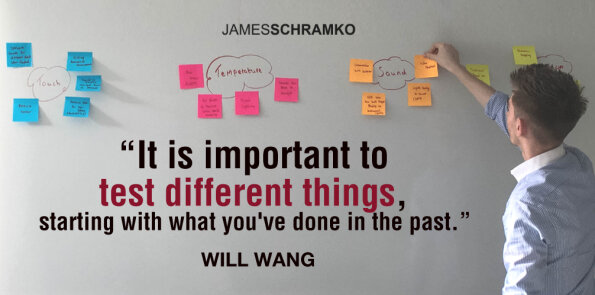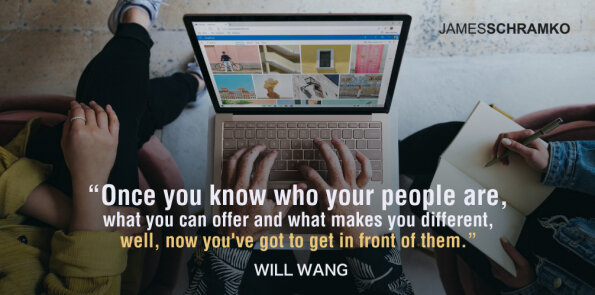Podcast: Download (Duration: 28:10 — 29.9MB)
Get Notified Of Future Episodes Apple Podcasts | Spotify | Amazon Music | Android | Blubrry | Gaana | TuneIn | Deezer | Anghami | RSS | More
Will Wang has made a career out of winning deals for his clients, some in the range of seven figures and up. In this podcast appearance, he shares the five-step process he uses.
In the episode, you’ll discover why research is crucial as the first step of a B2B sales strategy.
The next step in B2B deals is knowing who your target prospects are and what it is you can solve for them.
Also important in B2B sales is leveraging multiple channels to reach your target audience.
Table of contents
1. In this episode: a million-dollar-plus case study
2. The steps of achieving the deal
-
a. Research and reworking your offer and USP
b. Building your list and relevant message
c. The multi-channel approach
d. Nurturing your leads
e. Making the sale
In this episode: a million-dollar-plus case study
Growth Labz’s Will Wang has always been a popular guest on the show, and today he’s going back to his core – doing big deals with B2B businesses.
What you’re in for is an actual case study, a client of Will’s in the financial services space. Will is discussing from start to finish how they found the lead, the nurturing and sales process, and how they closed the seven-figure deal over a period of three years.
The whole thing involves five steps:
– Research
– List-building and formulating a relevant message
– Being present on multiple channels
– Lead-nurturing
– Sales
And as a bonus step, Will discusses the often-overlooked post-sale element.
The steps of achieving the deal
Research and reworking your offer and USP
Step one, says Will, is thinking through the campaign – the business, the market, the offer, the USP (unique selling proposition), all the background work that you don’t see in the campaign itself.
In Will’s example, they looked at five different industries, in which they tested campaigns – two flopped, two worked well, and one, in the healthcare space, really took off and outperformed the rest combined. It is important, says Will, to test different things, starting with what you’ve done in the past.
These days, too, a lot of markets have been overdone. So it’s always worth thinking about what your market’s doing, how sophisticated they are, and how many offers in different types of businesses like yours they’ve seen in the past.
Building your list and relevant message
With the first part done, we look into list building and the relevant message. Once you know who your people are, what you can offer and what makes you different, well, now you’ve got to get in front of them.
It’s all about making sure you’re targeting the right person at the right company, and making sure that company is qualified and has a need for what you actually do. You’ve also got to understand, what are their pains and frustrations, what are they looking for – this will help you approach them with a highly personalized message they’ll respond to.
The multi-channel approach
The next step is multi-presence, being on multiple channels to get your leads’ attention.
For Will’s client, they had emails, direct mail, LinkedIn outreach, and a sales team calling off the back of some of their outreach. Knowing how valuable every single lead was, it made sense to try and get in front of them as much as possible.
Nurturing your leads
Something that not a lot of marketing or lead generation companies talk about is the lead nurture process. With Will’s particular client, they looked at criteria that they were looking for from their clients, and there was a certain way of asking for it that got their leads and their clients to understand what they could do.
With a combination of email marketing, SMS, and video campaigns, the whole process was automated as well. So when they did book into a sales call, they’d be getting nurtured up to the point where they were on the phone with the salespeople – this was an important step in helping them to confirm or delete.
Because the leads had been nurtured, they knew that every single lead that went through was actually a quality lead. And then it became just a problem of whether their sales team was capable of actually closing those deals.
Making the sale
Step five is the most important step, or almost – the sales. And what’s important with this part is to really get someone onto leads quickly.
Will recommends following up within less than half an hour – that’s what they’ve found to be the optimal time. James agrees – the longer you put off calling, the less likely the sale.
Bonus step: Post-sale
The bonus step is the post-sale action, which again is something a lot of companies fail to focus on. It’s about, how can you surprise and delight your clients and reaffirm their decision point when they do sign up?
In Will’s company, what they do is send physical gifts to clients – hampers or goodies or books. Another thing they think about, even before the campaigns are launched, is how they can get their clients a result as soon as possible, so that they stay with them or return to them long-term.
In his Mercedes-Benz days, James would keep in touch with customers post-sale, calling them up to entertain questions or let them know when it was the optimal time to trade in. The sale was just the start of a relationship.
Join the community of thriving entrepreneurs inside the James Schramko community
Enjoyed the show? Leave us a review on iTunes













Leave a Reply